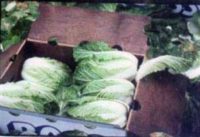Chinese Cabbage
 There are two major types of Chinese cabbage, the heading and the non-heading. The non-heading type under its most common name, Bok Choy is a rather open rosette of dark green leaves with white celery-like stalks. This plant is more heat tolerant but much more sensitive to cold which makes it bolt when it suddenly turns warm during winter or early spring. It grows very fast in fertile soil (45 - 55 days) and should be planted at 2 to 3 week intervals for constant supply. It can be harvested at the small plant stage or a few stalks at a time.
There are two major types of Chinese cabbage, the heading and the non-heading. The non-heading type under its most common name, Bok Choy is a rather open rosette of dark green leaves with white celery-like stalks. This plant is more heat tolerant but much more sensitive to cold which makes it bolt when it suddenly turns warm during winter or early spring. It grows very fast in fertile soil (45 - 55 days) and should be planted at 2 to 3 week intervals for constant supply. It can be harvested at the small plant stage or a few stalks at a time.
The heading types are known as Napa Cabbage or Michihili. Michihili has a tall cylindrical or tapered head while the Napa is a short barrel-shaped head. Neither of these Chinese cabbages look or taste like ordinary cabbage. They both have large cover leaves that are trimmed off to reveal the compact heads. They need space in the garden - 16 - 24 inches across.
Chinese cabbage is a heavy feeder; use compost made with manure and a constant supply of moisture. It is better to start plants in individual pots or cells as bare root transplanting will cause bolting in some types. To direct seed, plant ¼ inch deep in single rows or block on wide raised beds. Space heading types 1½ to 2 feet apart.
Planting Dates
Coastal:
Plants can be set out from September to February. Seeds can be planted from August to December.
Inland:
Plants can be set out from September to February. Seeds can be planted from August to Octobe
Varieties
Non-heading types - Lei Choi (47 days) Pak Choi (45 days).
There are now many introduced Asian types of cabbage which are very different from the European cabbages. There is also a problem with names, depending on which country or part of the country the seed is coming from. There are many new hybrids from Japan worth trying. Try some from specialty seed companies.

